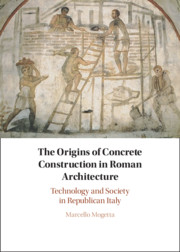
-
Select format
-
- Publisher:
- Cambridge University Press
- Publication date:
- June 2021
- June 2021
- ISBN:
- 9781108990516
- 9781108845687
- Dimensions:
- (247 x 177 mm)
- Weight & Pages:
- 0.796kg, 334 Pages
- Dimensions:
- Weight & Pages:
You may already have access via personal or institutional login
Book description
In this study, Marcello Mogetta examines the origins and early dissemination of concrete technology in Roman Republican architecture. Framing the genesis of innovative building processes and techniques within the context of Rome's early expansion, he traces technological change in monumental construction in long-established urban centers and new Roman colonial cites founded in the 2nd century BCE in central Italy. Mogetta weaves together excavation data from both public monuments and private domestic architecture that have been previously studied in isolation. Highlighting the organization of the building industry, he also explores the political motivations and cultural aspirations of patrons of monumental architecture, reconstructing how they negotiated economic and logistical constraints by drawing from both local traditions and long-distance networks. By incorporating the available evidence into the development of concrete technology, Mogetta also demonstrates the contributions of anonymous builders and contractors, shining a light on their ability to exploit locally available resources.
Reviews
'… [a] stimulating work … the bold thesis will inspire much discussion, in no small part because it rests on a keen understanding of the evidence … [Mogetta's] efforts deserve broad readership and serious engagement.'
Seth Bernard Source: American Journal of Archaeology
‘… an important resource in the discipline of construction history. The author collects a large quantity of information from recent excavations and previous studies, approaching different geographical contexts together with different architectural contexts.’
Sarah Vyverman Source: Bryn Mawr Classical Review
Contents
Metrics
Altmetric attention score
Full text views
Full text views help Loading metrics...
Loading metrics...
* Views captured on Cambridge Core between #date#. This data will be updated every 24 hours.
Usage data cannot currently be displayed.
Accessibility standard: Unknown
Why this information is here
This section outlines the accessibility features of this content - including support for screen readers, full keyboard navigation and high-contrast display options. This may not be relevant for you.
Accessibility Information
Accessibility compliance for the PDF of this book is currently unknown and may be updated in the future.


